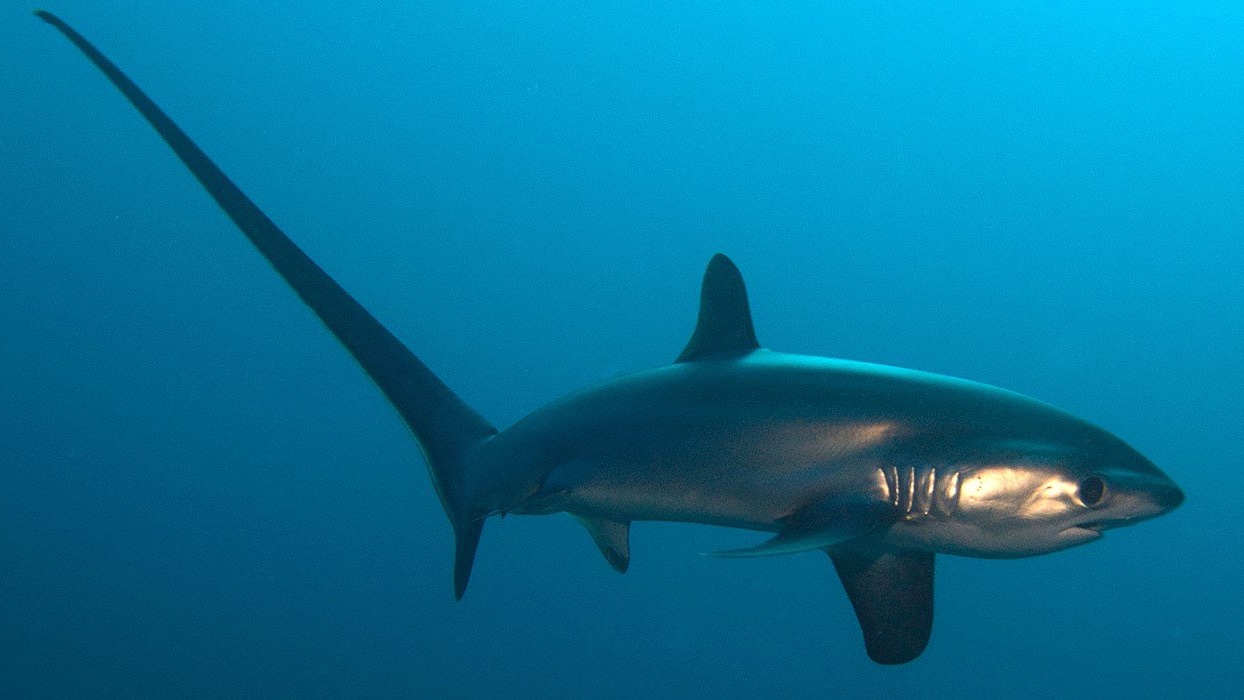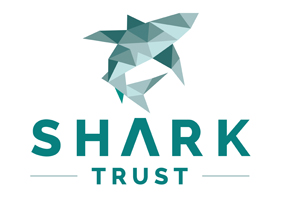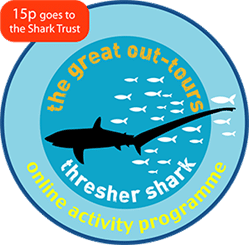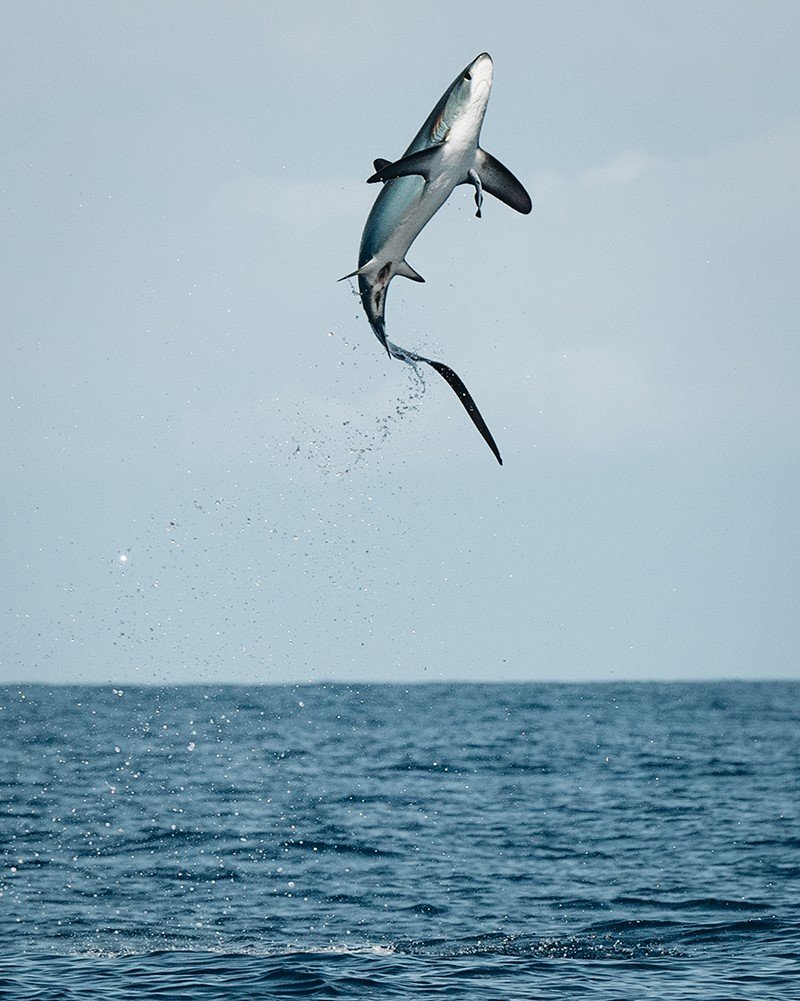Marine Life & Conservation Blogs
Creature Feature: Thresher Sharks

 In this new series, the Shark Trust will be sharing amazing facts about different species of sharks and what you can do to help protect them.
In this new series, the Shark Trust will be sharing amazing facts about different species of sharks and what you can do to help protect them.
This month they’re showcasing the super agile, fish-herding, thresher sharks. Made up of 3 different species, these sharks can whip up dinner at lightning speed…
Thresher Sharks are found in tropical and temperate seas all over the world. Highly migratory, they spend their time in coastal waters as well as the wide-open ocean. By day you’ll likely find them in deep waters, avoiding predators and dining on squid and octopus. But at night, they rise to the surface to hunt small fish.
During daylight hours they may also indulge in a spa. Taking regular trips into shallow coastal waters to visit cleaning stations. Here they get preened and pampered by hungry cleaner fish, who remove pesky parasites picked up during their long travels.
Yet, they are capable of doing this themselves. When cleaner fish are off duty, threshers will remove parasites by breaching out of the water. Check out the photo below – what an incredible sight to see!
To survive in cold deep waters, threshers – like the White Shark and Shortfin Mako – are endothermic. They have a network of tiny blood capillaries, which acts as a heat exchange system. Known as a rete mirabile, this keeps them nice and toasty. In fact, their body temperature can be 10°C warmer than the surrounding water.
But the most distinctive and exciting adaptation of thresher sharks is – of course – their incredibly long, whip-like tail. Shaped like a scythe, this marks impending doom for schooling fish. Making up around half the length of their entire body, their tails can reach up to 3m long! And they’re not just for show…
Hunting in small packs, threshers will use their tail to herd small shoaling fish – such as mackerel, herring and sardines. They’ll then charge into the shoal, thrashing their powerful tail, injuring and stunning their prey. Dazed and confused fish are then swiftly eaten. Larger individuals will also feed on bigger fish, like cod and tuna, as well as large deep-sea squid.
The first part of the thresher sharks’ scientific name is ‘Alopias’, which is Greek for fox. In ancient Greece, the philosopher Aristotle thought these sharks must have been as clever as a fox to avoid the nets and traps of fishermen. But sadly, this isn’t the case today. Due to modern destructive fishing practices, all 3 thresher shark species now face a high risk of extinction.
COMMON THRESHER SHARK:
Bluish to dark grey in colour, the Common Thresher has a pointed snout and small arched mouth.
Depending on the region, females reach maturity between 3 and 13 years. Males between 3 and 8 years. Females will give birth to litters of 2-6 pups in spring/summer, which can be as large as 1.5m! They’re thought to live up to 38 years.
- SCIENTIFIC NAME: Alopias vulpinus
- FAMILY: Alopiidae
- MAXIMUM SIZE: 5.8m
- DIET: Fish and squid.
- DISTRIBUTION: Most tropical and temperate seas around the world. They have a higher tolerance for cold water, than other thresher shark species.
- HABITAT: Coastal waters to the open ocean, from the surface to 650m deep.
- CONSERVATION STATUS: Vulnerable
BIGEYE THRESHER SHARK:
As their name suggests Bigeye Threshers have enormous eyes. These help them navigate and hunt in deep dark waters, and at night. Their eyes can be up to 10cm in diameter and sit within a keyhole-shaped socket, enabling them to rotate their eyes upwards.
Purple to brown-grey in colour, they have the most beautiful metallic hues on their back and flanks.
After a 12-month gestation period, females will give birth to litters of 2 (rarely 4) pups. These can be up to 1.4m long and may live up to 20 years.
- SCIENTIFIC NAME: Alopias pelagicus
- FAMILY: Alopiidae
- MAXIMUM SIZE: 4.8m
- DIET: Fish and squid.
- DISTRIBUTION: Most tropical and temperate seas around the world.
- HABITAT: Coastal waters to the open ocean, from the surface to 500m deep (usually 100m).
- CONSERVATION STATUS: Vulnerable
PELAGIC THRESHER SHARK:
Out of the 3 species, Pelagic Threshers are the smallest and least well-known. Similar in colour to the Bigeye but lighter. They give birth to litters of 2 pups every year and are thought to live around 19 years.
- SCIENTIFIC NAME: Alopias pelagicus
- FAMILY: Alopiidae
- MAXIMUM SIZE: 3.6m
- DIET: Fish and squid.
- DISTRIBUTION: Indo-Pacific Ocean
- HABITAT: Coastal waters to the open ocean, from the surface to 300m deep.
- CONSERVATION STATUS: Endangered
 Discover more with the Thresher Shark Activity Bundle. Brought to you by award-winning outdoor education provider – The Great Out-Tours.
Discover more with the Thresher Shark Activity Bundle. Brought to you by award-winning outdoor education provider – The Great Out-Tours.
Created for children and adults in care homes, these bundles of fun will provide hours of entertainment.
Wordsearches, jigsaws, arts and crafts, educational videos, a family quiz and so much more. All jammed packed into this bundle for just £1, with 15p going to the Shark Trust!
Image banner: Thresher Shark © Matt Newell
Blogs
Saba’s Plan for a Coral Comeback

Saba has an exciting new initiative to restore its coral reefs. This new project, running from 2024 to 2026, will focus on reviving key species in the island’s underwater ecosystems. With a collaborative team from the Saba Conservation Foundation (SCF) and Van Hall Larenstein (VHL) University of Applied Sciences, the project aims to restore both corals as well as sea urchins.
This initiative is centered around coral restoration, specifically reviving two essential coral species—staghorn coral (Acropora cervicornis) and elkhorn coral (Acropora palmata). By mapping parent colonies and using a technique known as coral gardening, SCF will create and maintain coral nurseries. These corals will eventually be outplanted at key reef sites around Saba to not only expand the number of coral colonies, but also provide essential fish habitat. The project focusses on installing coral nurseries, training staff with the newest techniques and starting with the restoration of key reef sites.

Reef Cleaners to the Rescue
It’s not just corals getting a makeover—this project also shines a spotlight on the essential role of grazers, particularly sea urchins. VHL is leading the charge on cultivating and restocking two key sea urchin species, West Indian sea egg (Tripneustes) and long-spined sea urchin (Diadema), known for their ability to keep algae in check. By removing algae, which are important competitors of corals, they help the coral to thrive. By restoring these “reef cleaners,” Saba’s project will give corals the breathing room they need to grow, setting the stage for a healthier, more balanced marine ecosystem.
From Tiny Urchins to Big Goals
The project will be funded as part of the Dutch Government’s Nature and Environment Policy Plan (NEPP) 2020-2030 for the Caribbean Netherlands, a comprehensive initiative aimed at conserving and restoring the unique natural environments of the Dutch Caribbean islands, including Saba, St. Eustatius, and Bonaire. This project is aiming for big milestones: build and maintaining coral nurseries, the expansion of urchin cultivation facilities, and the creation of a dedicated research center. By 2026, the project hopes to ramp up coral and grazer restoration, with the ultimate goal of extending these efforts across the Dutch Caribbean. By linking local initiatives to broader regional goals, Saba’s restoration project promises to leave a lasting impact on both the environment and the community.
Find out more about the DCNA at dcnanature.org.
Blogs
Reef-World marks two decades of marine conservation: strengthening impact amid coral reef threats

Empowering ocean stakeholders to tackle future challenges and ensure the survival of coral reefs and humanity
2024 marks the 20th Anniversary of The Reef-World Foundation’s tireless efforts for global coral reef conservation. The UK charity is the international coordinator of the UN Environment Programme’s Green Fins initiative, known as the leading voice in sustainable marine tourism. Today, Reef-World released its 2023-2024 Impact Report outlining a year of substantive growth and impact in its marine conservation programmes.

Impact Report Highlights:
- Impressive improvements in environmental behaviours to protect coral reefs by the marine tourism industry as the global participation of Green Fins increases.
- Continued capacity building for government and NGO staff to effectively manage marine tourism activities in Asia, Caribbean and Red Sea regions.
- For the first time in Green Fins’ 20-year history, tourism operators have achieved ‘Best Environmental Performer’ status by demonstrating the lowest possible environmental impact in their environmental assessments. In 2024, three dive operators achieved this challenging milestone.
- Significant increases in global participation of Reef-World’s innovative digital conservation tools.
- 138 Green Fins dive operator members achieved the strict threshold for PADI Eco Center recognition.
- Developed four new educational materials and translated two into 16 languages to support the marine tourism industry in achieving sustainability targets.
- Establishing a new Reef-World Development strategy and recruiting new roles – Development and Programmes Managers.
- Reef-World’s board welcomes new Chair and Trustees strengthening organisational leadership.

Reef-World started as a one-person mission to inspire and empower communities to act in conserving and sustainably developing coral reefs and related ecosystems. Today, the team of 12 continues to meet this mission by inspiring and empowering the global marine tourism community to be exemplary sustainability leaders by using the Green Fins guidelines and tools to simultaneously use and protect the world’s precious reefs.
In April 2024, the fourth global coral reef bleaching event was confirmed. Reef-World’s work has never been more urgent as the marine environment, and the benefits they provide humanity, continue to be eroded by global threats. The reduction of local threats, like those from the marine tourism industry, is an essential step to ensuring a future where coral reefs survive and continue to support the millions of people who depend on their ecosystem benefits. Reef-World’s work buys time for coral reefs and related ecosystems to be resilient to the impacts of global threats.
“Right now our corals are facing the greatest fight of their existence as the terrifying predictions of the steps towards their complete extinction are starting to come true. But all is not lost, reefs are resilient and they have existed on this planet for millions of years. We must take action now, to buy time for reefs by reducing threats facing them and allowing them to react and adjust to the changing environment they need to survive in.” – Chloe Harvey, Executive Director
Looking Forwards:
Like coral reefs, the Reef-World team needs to be resilient in the face of the complex challenges of the conservation sector. Reef-World has invested significantly in developing a Culture of Care to ensure the well-being of its team on a daily basis, continuing to be an exemplary employer to enable its team to best achieve the mission for coral reef conservation.
With the foundations of a Culture of Care and organisational development laid, Reef-World is emerging from the end of a natural organisation life cycle, that brings the challenges of growth and scale, stronger than ever. With a new strategy in place to generate much needed resources, Reef-World is excited for the opportunities to leap forward, continue to scale our impact and lean into new innovations and untapped opportunities for marine conservation.
We continually strive to become a forward-thinking organisation that delivers on our goals and commitments to our stakeholders with fresh approaches and not being afraid of steering away from a “normal approach.” This approach is not only applied to our programmes of work but also internally and carries over to our Culture of Care for our team.” — JJ Harvey, Operations Director

The Reef-World Foundation is immensely grateful for the continued support of its grant funders: UN Environment Programme, IUCN’s Blue Natural Capital Financing Facility, Adventure Travel Conservation Fund, PADI Aware Foundation, and World Nomads Footprints Program.
Reef-World would also like to express its gratitude to international partners whose vital support has resulted in significant tangible benefits for our work and mission: PADI; Professional SCUBA Schools International (PSS); Explorer Ventures; 1% for the Planet; ZuBlu; Snorkel Venture, GSTC; Dive O’Clock; Seven Dragons; DiveAssure and Eco Beach, without whom these achievements would not be possible.
The full 2023–2024 Annual Impact Report is available on Reef-World’s website.
-

 News2 months ago
News2 months agoIconic SS United States to become the World’s Largest Artificial Reef
-

 News3 months ago
News3 months agoBook Review – 52 Assignments: Underwater Photography
-

 Gear News3 months ago
Gear News3 months agoDYNAMICNORD – New German diving brand enters the British market
-

 News3 months ago
News3 months agoExploring Cenote El Pit: A Diver’s Dream
-

 Gear News3 months ago
Gear News3 months agoTry BARE drysuits (and maybe even win one!) this Friday with Sea & Sea at North West Dive Fest
-

 Marine Life & Conservation3 months ago
Marine Life & Conservation3 months agoBook Review: Coral Triangle Cameos
-

 Blogs2 months ago
Blogs2 months agoDive the Egyptian Red Sea this Autumn with Regaldive
-

 News3 months ago
News3 months ago2024 Ocean Art Underwater Photo Competition Announced
















